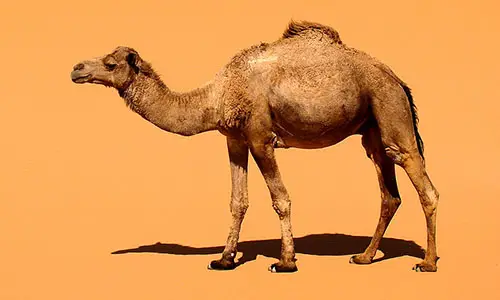- Camels belong to the group of chewing, herbivorous mammals. They are beloved for their lengthy even-toed legs, and inimitable fat deposits on their back termed as “humps”. Based on the number of humps, they are categorized as dromedary or single-humped and Bactrian or double-humped camels. Dromedary camels exist in Middle East of Africa and the latter dwells in Asia.
- A camel survives for about 40 – 50 years. The stored fat constituted in camel’s hump is mainly useful for its existence whilst there is a scarceness of water and food. Not only this, camels have many other unique characteristics that chiefly help them to stay active in their environment. For instance, it has a lucid eyelid to defend their eyes from fluttering sands. In addition to this, camels can also close up their nostrils in sand storms. They are first-rate swimmers with superb sense of vision and odour.
- There are totally 17 million camels in the world. 75 % of the dromedaries subsist in North, East Africa, 50 % of the total dromedaries stay in Sudan and Somalia, and 15 -20,000 dromedaries rove in Central and Western Australia.
- Camels are prominently recognised for its milk, leather, meat and wool produces.
Wow, baby camels are amazing!
- Baby camels are usually born devoid of humps. However, they could run in hours after birth. They call their mothers with a “baa” sound, which is identical to that of a lamb. Apparently, both the mother and child camel bonding is exceedingly intimate, that they reside together for many years. Camels have small and hairy ears with a great sense of hearing.
- Baby camel weighs up to 25-50 kg and measures 1.2m in height.
Hunt for food goes on
- Camels can walk 3 km in a day in 3 hours, searching for food and scatters in lack of food. Daily, they need 10-20 kg of food based on its size. They expend 8-12 hours a day for eating. They drink around 7 litres of water in a day. The most annoying habit of camel is spitting. It does so in intense fury and disappointment.
How does dromedary and Bactrian camels differ?
- Dromedary camel males weigh 400–600 kg, whereas females weigh 300–540 kg. Dromedaries comprise solid eyelashes and eyebrows with a hump measuring up to 20 cm. The diet of the dromedary camel includes, grasses, desert herbages like, desert bushes, cactuses, acacia, salsola, etc.
- Bactrian camels’ mass widely varies from 300 to 1000 kg, where mostly males are heftier than females. Bactrian camels can withstand extreme temperature, such as biting cold or fiery heat. One among the rare variety, Wild Bactrian camels continue to exist in the Gobi desert situated amidst China and Mongolia.
Admirable means of transport
Camels are “ships of the desert” because they largely assist humans as a means of transport for years now. A camel can bear around 500 pounds on their backs.
Amusing Camel Doings
- Camel wrestling is a habitual sport played in Turkey. In this game, two male camels wrestle against each other. In recent times, it takes place in other regions, like South Asia and Middle East.
- Apart from this, camel racing is quite popular in Saudi Arabia, Jordan, Bahrain, Pakistan, Egypt, Qatar, Mongolia, UAE, Australia and Oman. The best part of camel racing is that it facilitate betting, tourism and is similar to horse racing.
- Camels usually sprint at a speed of 65 km/h in short trails and they can sustain a pace of 40 km/h for an hour. At the time of race, child jockeys keep camels under control. This has outraged and resulted a countrywide ban in Qatar and UAE for using young children as labour during the race. One of the biggest camel race occurs in Australia at “The Boulia desert Sands” which offers a prize money of A$25,000.









Leave a Reply